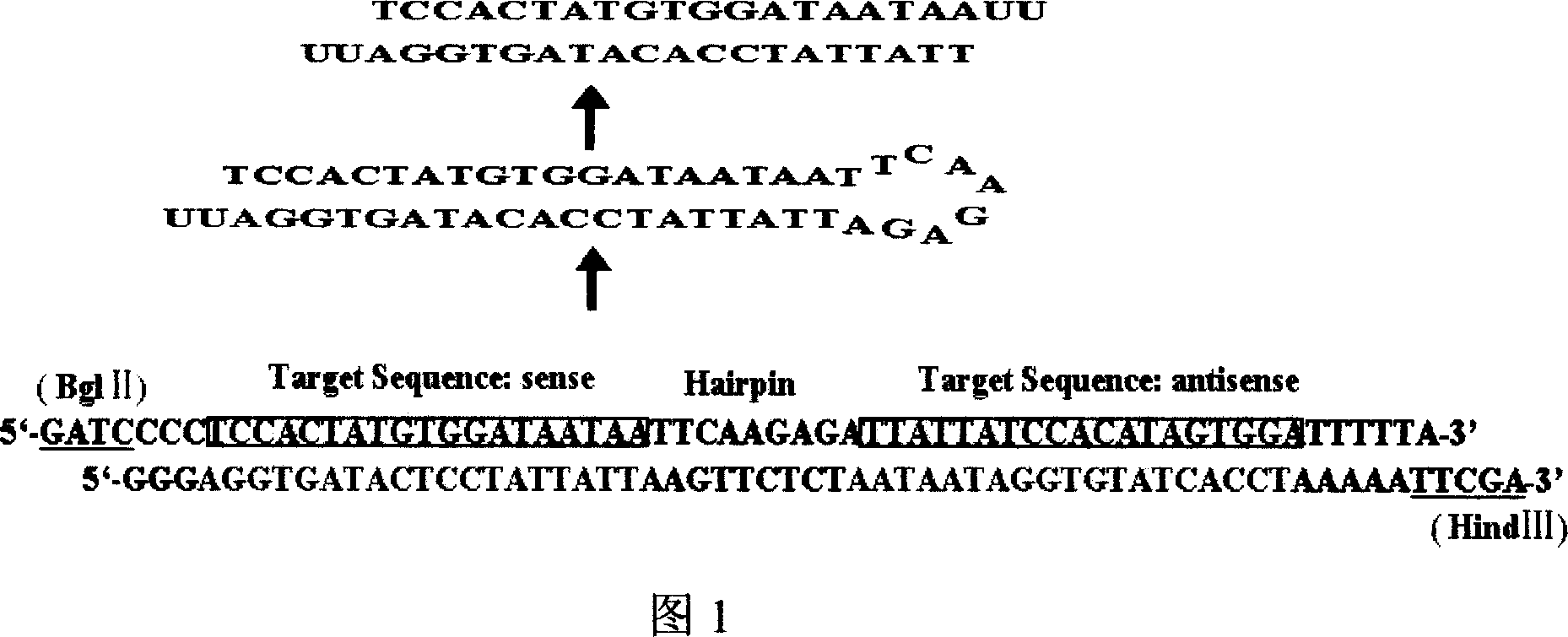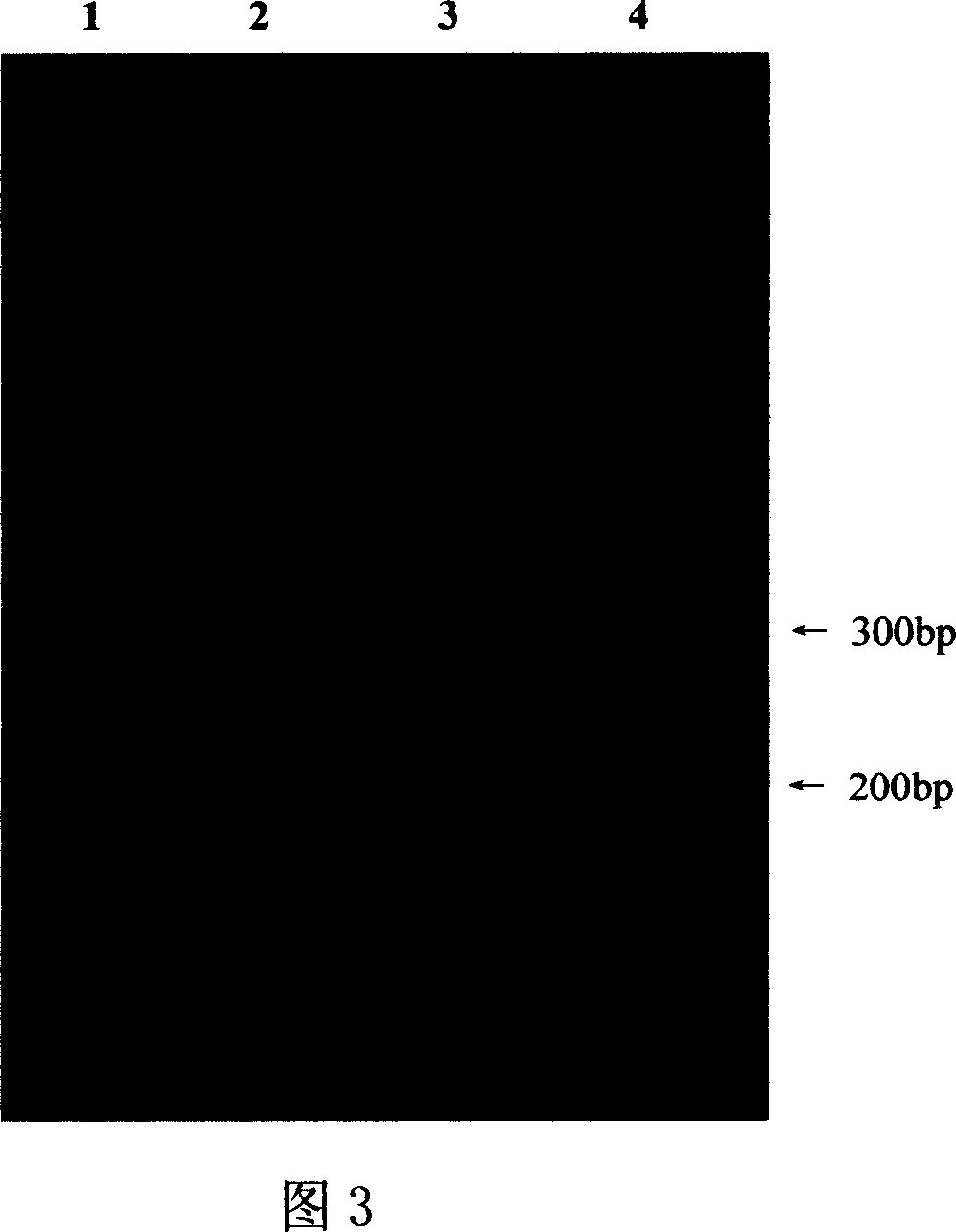Application of siRNA suppressing human Ezrin gene expression in the research on esophagus carcinoma proliferation
A gene expression and cancer cell technology, applied in the field of siRNA, can solve the problem that the mechanism of Ezrin function and its expression change has not been well elucidated
- Summary
- Abstract
- Description
- Claims
- Application Information
AI Technical Summary
Problems solved by technology
Method used
Image
Examples
Embodiment 1
[0045] Example 1 Design, synthesis and annealing of siRNA targeting Ezrin gene.
[0046] Two sets of siRNA sequences were designed according to the design software provided by Dharmacon on the Internet, as shown in Table 1:
[0047] siRNA Target Sequence
Region
start
5'TCCACTATGTGGATAATAA3' (SEQ ID NO: 3)
PSE1
ORF
274
5'ACTTTGGCCTCCACTATGT3' (SEQ ID NO: 4)
PSE2
ORF
265
[0048] The design principles are as follows:
[0049] (1) Starting from the AUG start codon of the mRNA, look for 5'AA(N19)TT,
[0050] Where N is any base, and the sequence length is 19bp (as shown in Table 1);
[0051] (2) Three or more G or C cannot appear consecutively on the target sequence;
[0052] (3) Avoid the interference sequence at the beginning and end of the target gene;
[0053] (4) Select sequences with a GC content between 30% and 52%;
[0054] (5) targeting the ORF region;
[0055] (6) Homology comparison o...
Embodiment 2
[0058] Construction of embodiment 2 expression vectors PSE1 and PSE2
[0059] 1. Linearization and recovery of the carrier: Add the following reagents in sequence to the centrifuge tube (total volume 50 μl): 37.5 μl of sterile water, 5 μl of pSUPER.neo vector, 5 μl of 10× buffer B, 0.5 μl of acetylated BSA (10 mg / ml) μl and HindIII (20u / μl) 2μl. After mixing, add 2 μl of BglII (20u / μl) to the mixture after incubating in a 37°C water bath for 1 hour, and incubate in a 37°C water bath for another 1 hour. Take 5 μl of electrophoresis for 1% agarose gel electrophoresis, and use the undigested plasmid as a control to identify whether the vector has become linear. Recover the linear pSUPER.neo vector fragment according to the instructions of the Quick PCR purification kit.
[0060] Add 5 times the volume of PB buffer to the enzyme digestion mixture, then transfer the mixture to the QIAquick spin column, centrifuge at 12000×g for 1min; discard the effluent, add 750μl PE buffer to t...
Embodiment 3
[0063] Embodiment 3 Analysis of stable transfection and interference effect
[0064] The identified recombinants were transfected into human esophageal cancer cell line EC109 cells, and an empty vector was also transfected as a control. In order to obtain cells stably expressing the plasmid, we first used a higher concentration of G418 (400μg / ml) for drug screening. EC109 cells transfected with blank plasmid PSCs and cells transfected with the above siRNAs (referred to as PSE1 and PSE2, respectively) survived due to the neo gene on the plasmid vector, which has G418 resistance; in contrast, untransfected The control EC109 cells with the above plasmids were killed by G418 toxicity. In order to prevent the loss of the expression plasmid during continuous subculture, the cells are still cultured in a growth environment with a relatively low drug concentration (200 μg / ml). If the plasmid is lost, the cells will still be killed due to the toxic effect of G418 . Under the above c...
PUM
 Login to View More
Login to View More Abstract
Description
Claims
Application Information
 Login to View More
Login to View More - R&D
- Intellectual Property
- Life Sciences
- Materials
- Tech Scout
- Unparalleled Data Quality
- Higher Quality Content
- 60% Fewer Hallucinations
Browse by: Latest US Patents, China's latest patents, Technical Efficacy Thesaurus, Application Domain, Technology Topic, Popular Technical Reports.
© 2025 PatSnap. All rights reserved.Legal|Privacy policy|Modern Slavery Act Transparency Statement|Sitemap|About US| Contact US: help@patsnap.com



